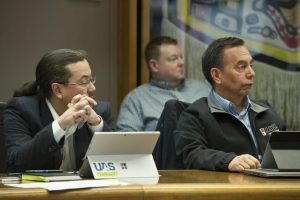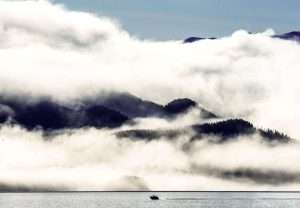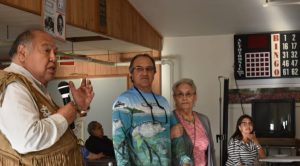Q&A with Board Youth Advisor Breylan Martin
by Communications Intern Tara Moreno-Goodwin

The Sealaska board of directors selected Breylan Náajeyistláa Martin as the 2023-2025 BYA based on her knowledge, experience and passion for serving people and culture. Martin will deliver valued insight to the Sealaska Board while gaining knowledge of Sealaska’s operations and mission.
Martin’s Tlingit name is Náajeyistláa (mother of Cape Spencer), which was the name of her great grandmother. Martin’s clans originate from what is now known as Glacier Bay. She is a Raven-T’akdeintaan from X’áakw Hít and a child of the Wooshkeetaan. Martin is currently pursuing her Ph.D. in Ethnic Studies at the University of California, Berkeley and recently started the Indigenous Language Speaking Certificate through the University of Alaska Southeast. We had the opportunity to talk with Martin to discuss what the position means to her and her outlook for the future.
Q: What motivated you to apply for the Board Youth Advisor position?
A: I first applied to the culture and history department based on one of my academic advisors’ suggestions because they knew I wanted to work for Sealaska, but I didn’t really know what I was interested in or what I was qualified for.
Coming with the background of religion and anthropology, they helped me select the culture and history department internship that was done through the collections and archives over at Sealaska Heritage. Ultimately, it ended up being the best position I could have wanted and has really set me on my career path by providing me with professional training. After that first internship, I realized I wanted to continue working with Indigenous collections and working on protecting and preserving our objects of cultural patrimony. That’s why I applied for a master’s degree to continue my education. Sealaska has set me up for my career path and I think [serving in the BYA role] is coming full circle of all of the programs Sealaska offers. The scholarships, the internships, all of them have really formed me and set me on my way. Coming back to the Board Youth Advisor Position is a way for me to say, “Here are all the lessons that you guys have taught me, I want to contribute and reciprocate these gifts. I want to honor you by using the skills you trained me with for all of us.”

Q: One year from now, what do you hope to accomplish in this position?
A: I first want to say that I’m so grateful that, one year from now, I will still be in this position. My first year, I really hope to listen and learn from the board, especially from Connor, my senior Board Youth Advisor. It will be important for me to continue absorbing all of the wisdom and knowledge our board has and that Sealaska Corporation can offer. I also want to use this position to offer up my strengths — I’m being trained as a researcher right now through my Ph.D. studies. I hope to be helpful by using these skills. So, one year from now, with all these new insights, I plan on diving deeper into repatriation and landless issues.
Q: How has your Tlingit heritage shaped your personal and professional goals?
A: This is another area for me to give a lot of gratitude to Sealaska. We always had small lessons and stories by our family, but I grew up largely not being motivated from and grounded with my Tlingit heritage. Coming to Sealaska was the first time I learned my introduction and the first time I really memorized my clans and the places where I’m from. Having that opportunity to learn how to work in a ‘professional sphere’ while relying on Indigenous values was when I became oriented and motivated by my Tlingit heritage. It’s been a huge learning process and I have so much gratitude to give my bosses, mentors and especially my family who has welcomed me back home lovingly and reminded me of my obligations.
Q: What inspired you to choose your area of study as well as your focus on Indigenous language revitalization?
A: I’m in the middle of my Ph.D. program in Ethnic Studies, and am doing the Native American Studies track. Pursuing education has meant I have had the time to learn about our history and culture, develop skills around my interests, and learn how to enact my responsibilities to my clan and community. It also comes from the understanding that education has historically been used as a tool for colonization — as a means to assimilate us and teach us values that do not center our history, culture, or sovereignty. So, it is also my goal to use the tools of western institutions in ways that honor our Native ways of life and looks towards the future by being grounded in our past. Learning Lingít runs along those same lines, our elders say that our language carries us and that we have always been people resilient to change and hardship because of our values. I take them seriously and love learning our language.
Q: What are your goals following your term as Board Youth Advisor?
A: After I finish my two years as Board Youth Advisor, I will still have two more years left in my Ph.D. studies. I’m hoping that my time as BYA not only gives me the space to provide the research skills that I’ve become equipped with, but also to tune my skills more finely in a way that’s relevant, important and useful to our people. My hope is to finish my Ph.D. studies and then become a professor, teaching in areas like Indigenous theory and Alaska Native histories, topics that would be useful to us.
Q: What insight and advice do you want to share with our youth?
A: I think the gift that Sealaska gave me is the opportunity to come back home to Lingít Aaní. Being home gave me such a tremendous opportunity to learn more about myself. Being home was such a transformative experience that helped me learn so much about our culture and our land in ways that I wouldn’t have been able to otherwise. So, I would say, apply to any opportunities to get you home on Lingít Aaní, pursue knowing yourself by knowing your history and where you came from.
Q: Is there a phrase or saying in Lingít that holds special importance or inspiration to you?
I love reading through the Lingít oratory work done by Nora Marks Dauenhauer and Richard Dauenhauer, especially Haa Tuwunáagu Yís For Healing Our Spirit. I always go back to the speech my clan sister, Naa Tláa Jessie Dalton made for Kuháanx‘ Jim Marks’ party — I appreciate being able to learn about our language and at.óow from her in this way. She says:
Yaa gax̱latídín yú aas.
Aag̱áa áwé yan g̱alaháshín
g̱agaanch áwé a kát x̱ʼus.utsóowch.
Du tóodei áwé yaa gaxúkch
du tula.eesháani.
Yáa yeedát áwé yee káxʼ gági yawdzi.áa yá g̱agaan
ax̱ léelkʼw hás lʼax̱keidí.
Yáa yeedát
gu.aal kwshé yee tóodei wuxoogu yáx̱ wooteeḵ
yee tula.eesháani.
which translates to:
How that tree rolled for a while on the waves.
Then when it drifted to shore
the sun would put its rays on it
it would dry its grief
to the core.
At this moment the sun is coming out over you, my grandparents’ mask.
At this moment
my hope is that your grief
be like it’s drying to your core.
I am a beginning language learner and am so grateful for all of the Lingít resources we have. I am also so grateful for our Elders who gave us these oratories to comfort us and preserved them to guide us.ing









 Previous
Previous